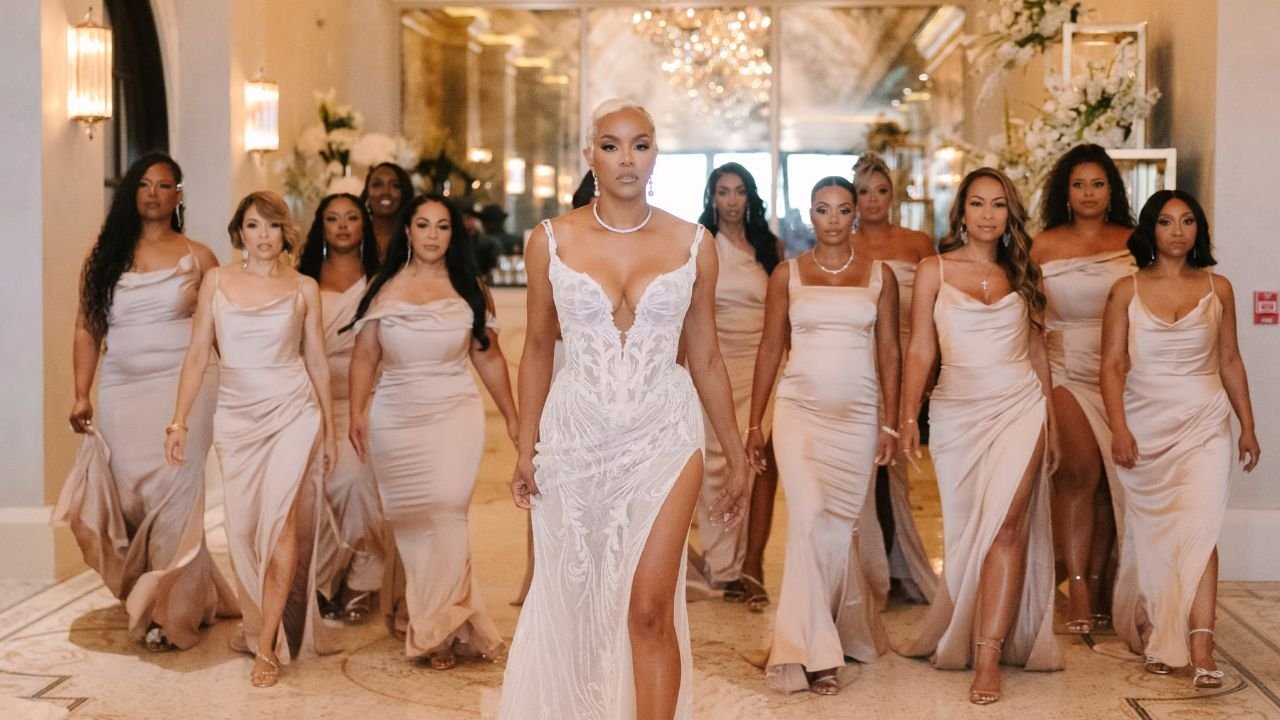Introduction
Weddings are moments of celebration, love, and personal expression. For many brides, choosing the perfect gown encapsulates their style, personality, and the significance of the day. When Letoya Luckett, the acclaimed singer, actress, and fashion icon, announced her wedding, fans and fashion enthusiasts eagerly anticipated her bridal look.
On her special day, Letoya stunned everyone by wearing a breathtaking white embellished gown designed by Ese Azenabor, a rising star in the world of haute couture known for his intricate craftsmanship and innovative designs. Her choice of a custom-made gown not only reflected her elegant style but also showcased her appreciation for artistry and cultural sophistication.
In this article, we delve into the details of Letoya Luckett’s wedding, explore the design and significance of her Ese Azenabor gown, highlight the designer’s journey, and analyze how her style choice influences bridal fashion and cultural expression.
1. The Wedding Day: A Celebration of Love
The Venue and Setting
Letoya Luckett’s wedding took place in an intimate, elegant setting—perhaps a lush garden, a luxurious estate, or a scenic outdoor location—that complemented her refined style. The ambiance was filled with love, joy, and the warmth of family and friends celebrating her union.
The Moment of the Gown Reveal
As she stepped into her wedding ceremony, all eyes turned to her. Her gown, a masterpiece of design and craftsmanship, radiated elegance and individuality. The moment was captured in photos and videos that quickly circulated on social media, inspiring brides-to-be and fashion lovers alike.
The Theme and Style
The overall wedding theme reflected sophistication and cultural depth, with elements that may have included personalized touches, meaningful decor, and a celebration of heritage. Letoya’s gown was the centerpiece—an embodiment of her taste, personality, and the significance of her wedding day.
2. The Gown: An Exquisite Creation by Ese Azenabor
The Designer: Ese Azenabor – Rising Star in Couture
Ese Azenabor, a Nigerian-born designer based in London, has garnered international acclaim for his avant-garde approach to fashion, blending traditional African aesthetics with contemporary design. His work is characterized by intricate beadwork, rich textures, and innovative silhouettes that celebrate cultural heritage and modern elegance.
Azenabor’s journey began with a passion for craftsmanship and storytelling through fashion. His collections often feature handcrafted embellishments, vibrant fabrics, and meticulous attention to detail, making each piece a work of art. His reputation for creating show-stopping bridal gowns has grown steadily in recent years, earning him a dedicated following among celebrities and fashion connoisseurs.
The Inspiration Behind the Gown
Letoya approached Azenabor with a desire for a gown that balanced classic bridal elegance with cultural significance and contemporary flair. The designer drew inspiration from African artistry, incorporating traditional motifs, patterns, and embellishments into a modern silhouette.
The gown was designed to reflect Letoya’s personality—regal, graceful, and bold. Azenabor’s vision was to create a piece that would honor her individuality while celebrating her heritage.
Design Details and Craftsmanship
Fabric and Silhouette:
The gown was crafted from luxurious satin or silk, providing a smooth, flowing base. It featured a fitted bodice that accentuated Letoya’s figure, with a dramatic, flowing skirt that created movement and grace.
Embellishments:
What truly set this gown apart was the extensive embellishment work. Azenabor meticulously hand-sewed beads, sequins, and intricate embroidery across the bodice and train. The embellishments might have included traditional motifs—geometric patterns, symbols of cultural significance—reinterpreted in a contemporary style.
Neckline and Sleeves:
The gown’s neckline could have been a sweetheart, off-shoulder, or bateau style, adding to its elegance. Sleeves—perhaps cap, long, or illusion—were adorned with beadwork or embroidery, balancing tradition and modernity.
Train and Details:
A long, lavish train added drama to the look, with embellishments that shimmered under the ceremony lights. The back of the gown might have featured an open or illusion design, with embroidery cascading down.
Accessories and Veil:
Complementing the gown was a delicately embroidered veil or headpiece, possibly incorporating traditional African elements such as bead crowns or headbands, further tying into her cultural roots.
3. The Cultural Significance and Personal Meaning
Celebrating Heritage Through Fashion
Letoya Luckett’s choice of an Ese Azenabor gown was more than a fashion statement; it was a celebration of her African heritage and an expression of cultural pride. Incorporating traditional motifs and handcrafted embellishments allowed her to honor her roots while embracing modern bridal elegance.
Empowerment and Representation
As a prominent Black woman in the entertainment industry, Letoya’s decision to wear a gown inspired by African artistry sends a powerful message about representation and cultural identity. Her bridal look showcased the beauty of African craftsmanship on a global stage, inspiring other women to embrace their heritage confidently.
Personal Touches and Customization
The gown was likely personalized with meaningful details—perhaps symbols, initials, or motifs that resonated with her journey and love story. Such touches made the gown uniquely hers, reflecting her personality and the significance of the day.
4. The Designer’s Journey and Impact
Ese Azenabor’s Rise in Fashion
Ese Azenabor’s journey is one of passion, talent, and cultural storytelling. Born and raised in Nigeria, he developed an early appreciation for traditional textiles, beadwork, and craftsmanship. Moving to London to pursue fashion, he blended his cultural heritage with contemporary design techniques, creating a distinctive aesthetic that bridges continents.
His work gained recognition through fashion weeks, celebrity collaborations, and red carpet appearances. Azenabor’s bridal collections have been celebrated for their craftsmanship, cultural depth, and innovative designs.
Influence on Bridal and Red Carpet Fashion
Azenabor’s designs have become a favorite among celebrities seeking unique, culturally infused couture. His ability to marry traditional African aesthetics with modern silhouettes has positioned him as a trailblazer in the fashion industry.
Commitment to Cultural Preservation
Azenabor’s work emphasizes preserving and celebrating African craftsmanship, supporting artisans, and promoting sustainable, handcrafted fashion. His gowns not only serve as stunning pieces but also as vessels of cultural storytelling and empowerment.
5. Style Analysis and Impact
A Fusion of Tradition and Modern Elegance
Letoya’s gown exemplifies how traditional motifs can be integrated into contemporary bridal fashion. The intricate beadwork and embroidery pay homage to African artistry while the silhouette adheres to modern standards of elegance and sophistication.
Setting a Trend in Bridal Fashion
Her choice inspires brides worldwide to consider incorporating cultural elements into their wedding attire. It challenges the notion of bridal fashion as solely Western-centric and encourages embracing diversity and heritage.
Cultural Representation and Empowerment
By choosing a gown that celebrates her roots, Letoya empowers women of African descent to see their culture reflected in their most important moments. Her bridal look promotes pride, identity, and self-expression.
Elevating African Designers
Her endorsement of Azenabor’s work shines a spotlight on African talent, opening doors for more recognition and opportunities for designers rooted in cultural artistry.
6. The Wedding Ceremony and Celebrations
The Ceremony
The wedding ceremony was a reflection of elegance, love, and cultural richness. Whether it was a traditional African wedding, a modern fusion, or a mix of both, the gown’s design made a statement about embracing heritage with grace.
The Reception
The celebrations likely included traditional music, dance, and cuisine, all infused with cultural pride. Letoya’s gown, along with her accessories, served as a visual centerpiece—an embodiment of her personal journey and cultural identity.
The Aftermath and Social Media Response
Photos and videos of her wedding flooded social media, with fans and fashion enthusiasts praising her gown and celebrating her cultural expression. Many highlighted the significance of her choice, inspiring others to honor their heritage through fashion.
7. Broader Cultural and Fashion Significance
Promoting African Artistry in Bridal Fashion
Letoya’s gown underscores the importance of showcasing African craftsmanship on global platforms. It highlights the beauty, complexity, and richness of traditional artistry, encouraging a broader appreciation.
Challenging Beauty Standards
Her bridal look challenges conventional beauty norms, emphasizing that elegance and sophistication can be rooted in cultural authenticity. It promotes diversity and inclusivity in bridal fashion.
Inspiring Future Generations
Her choice serves as a powerful role model for young women and aspiring designers, demonstrating that cultural heritage can be a source of pride and innovation in fashion.
8. The Future of Cultural Bridal Fashion
Embracing Heritage and Innovation
Designers and brides alike are increasingly blending traditional elements with modern silhouettes. The success of Azenabor’s gown in a high-profile wedding sets a precedent for culturally inspired bridal fashion.
Supporting Artisans and Sustainable Fashion
The movement toward handcrafted, sustainable bridal gowns not only celebrates artistry but also supports local communities and artisans.
Personalization and Meaning
Custom gowns that incorporate meaningful symbols, motifs, or craftsmanship will continue to grow in popularity, emphasizing the importance of personal stories and cultural identity.
9. Conclusion
Letoya Luckett’s wedding was a celebration of love, culture, and artistic expression. Wearing a stunning white embellished gown designed by Ese Azenabor, she not only honored her heritage but also set a new standard for culturally infused bridal fashion. Her gown, a masterpiece of craftsmanship, symbolizes the beauty of blending tradition with modern elegance.
Her choice highlights the importance of representation, cultural pride, and the power of fashion as storytelling. As her photos and videos continue to inspire, it’s clear that her wedding gown will be remembered as a symbol of empowerment, artistry, and personal expression.
Letoya Luckett’s bridal look reminds us all that the most beautiful fashion statements are those that reflect our true selves, our roots, and our journey—crafted with love, artistry, and authenticity.

